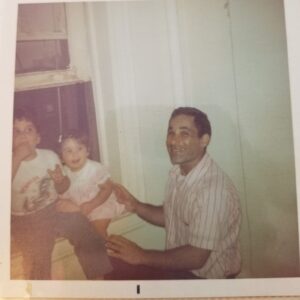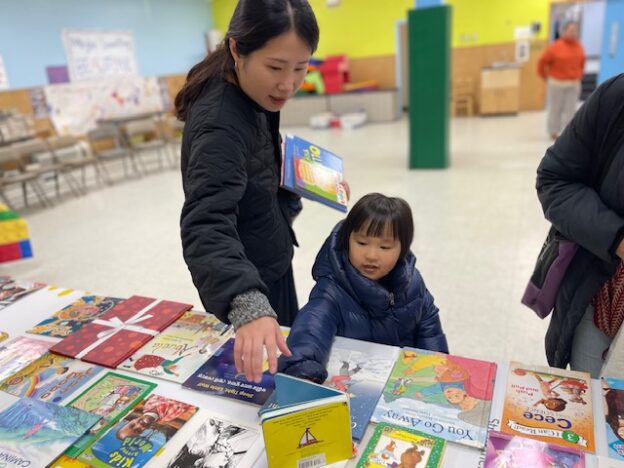Three team members share their journeys from participant to staff—and sometimes both.
Anjolaife (AJ) Ahmed, Group Leader, Hammel Houses Cornerstone Community Center

AJ, far left in the back row, and his partner Iyanla Walcott (also a group leader; in the center with green hair) with their group.
My journey with The Child Center of NY began in 2018 at the Hammel Houses Cornerstone Community Center. At that time, I joined Team Crate, a co-locator basketball team, and was first introduced to the center. The community center quickly became a second home for me, offering not only a safe space, but also an incredible facility where I could practice with my teams. This environment helped me excel in my high school basketball career and continues to support me as I pursue my college basketball career.
In 2021, I had the privilege of meeting Ms. Amanda Etienne, The Child Center’s Senior Vice President of Youth Development, at a local Carvel. I was inquiring about job opportunities when Ms. Etienne graciously took my information and referred me back to Ms. Krystle, who was the director of the program I attended with Team Crate. Coincidentally, Ms. Krystle had been instrumental in my initial introduction to the center. Despite it being the middle of the summer, I was quickly placed in a position at the center, and Ms. Krystle has supported me throughout my journey ever since.
Throughout my time working at The Child Center of NY, Ms. Krystle has worked with me to ensure that I could maintain my employment while balancing my collegiate studies, basketball schedule, and changing commitments. This flexibility has been invaluable, and I deeply appreciate the support.
This job has taught me not only the importance of professionalism and responsibility, but also crucial life lessons. Working with kids and teens has inspired me to continue my journey in youth development, as it has shown me the positive impact I can have on the lives of young people. I am truly grateful for the opportunities provided to me by The Child Center of NY and for the ongoing support I receive from the Hammel Houses Cornerstone community.
Dionte Davis, Group Leader, Hammel Houses Cornerstone Community Center

Dionte and Prince, now a seventh grader, en route to Splish Splash. The team takes fifth-grade participants on this trip every year to celebrate their graduation from the afterschool program.
My experience with The Child Center of NY Hammel Houses Cornerstone Community Center began when I was a young teen. I became an active participant at the center, particularly enjoying the open gym sessions in the evenings. I would attend almost every day. Over the years, I have had the privilege of getting to know the staff very well. I often talk about how short and young I was when I first met them, and now, as I look back, it’s clear how much the Cornerstone community has shaped my life.
Through my pre-teen and teenage years, I remained an active part of the community center, even through renovation and relocation stages. While attending open gym and playing basketball, I began to inquire about job opportunities at the center. Ms. Krystle, who had known me since I was a young boy, quickly agreed to offer me a position. Over the course of our interactions, she saw my potential and expressed confidence that I would be a great group leader, and that belief has stuck with me.
Working at the center has taught me invaluable lessons about working with kids, understanding their unique needs, and recognizing how each child learns differently. It has been a truly fun and rewarding experience, and every day I learn something new. My passion for working with kids has only grown, and I hope to continue contributing to the community. In fact, one day I hope to be in the same position as Ms. Krystle, leading and mentoring the next generation of young people.
I am incredibly grateful for the opportunities I have been given by The Child Center of NY, and I look forward to continuing this journey in making a positive impact on the lives of the children I work with.
Micha Simon, Office Manager, Oceanside Cornerstone Community Center
 Prior to my employment with TCCNY, I was a client of the organization. My daughter participated in the afterschool and summer camp programs, and my sons were in the evening programs for the middle and high school kids. As for myself, I participated in the adult programs, including running the Saturday bingo activity and helping out at center events in whatever capacity I was needed. Though I am now an employee and my daughter is now in middle school, we are all still participants in the center.
Prior to my employment with TCCNY, I was a client of the organization. My daughter participated in the afterschool and summer camp programs, and my sons were in the evening programs for the middle and high school kids. As for myself, I participated in the adult programs, including running the Saturday bingo activity and helping out at center events in whatever capacity I was needed. Though I am now an employee and my daughter is now in middle school, we are all still participants in the center.
Being a client family and from the neighborhood helps with my job in a positive way since I’m a familiar face to the staff, parents, and kids, and they are all familiar to me. My children have benefited tremendously from the programs they have participated in, developing strong friendships and social skills. I also have benefited from the program in the sense that I have made friends, enhanced my social and emotional skills, and found an outlet to volunteer and give back to my community.
The Oceanside Cornerstone Community Center means a great deal to my family. Growing up in the Caribbean, we have this saying, “It takes a village.” Now it means I get to be a part of somebody’s village as an Oceanside Cornerstone team member and community member. We are all there for each other.














 Here are Antony and Ava, also third graders, casting their votes and learning about the workings and importance of democracy.
Here are Antony and Ava, also third graders, casting their votes and learning about the workings and importance of democracy.
 As the Director of Clinical Best Practice at The Child Center, Diane Valente, LCSW-R, supports our clinicians in delivering high-quality, evidence-based
As the Director of Clinical Best Practice at The Child Center, Diane Valente, LCSW-R, supports our clinicians in delivering high-quality, evidence-based 
 Mehak Mahmood is a Program Director at our
Mehak Mahmood is a Program Director at our 










You must be logged in to post a comment.